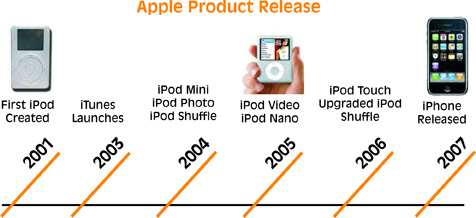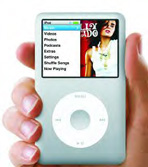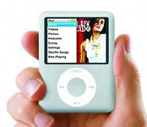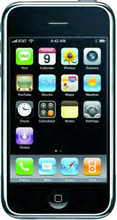MP3 Players Through the Years
The first MP3 player, the MPMan, was produced in 1998. It held 32 megabytes (MB) of memory. One megabyte played about one minute of music, so this player couldn't hold many more than eight or nine songs. The unit sold for $250.00, but, for an additional $69.00, you could upgrade your memory to 64 megabytes!
Kilobytes, Megabytes, Gigabytes
What do we mean when we refer to megabytes and gigabytes of memory? It all starts with a bit. A bit is a binary digit. It is used in binary code, a language computers understand, that uses only two digits, 0 and 1, to process information.
A bit is a basic unit of information storage, or memory. A string of eight bits makes a byte. A byte holds only a very small amount of information, so we usually talk about memory in terms of kilobytes (KB), which is 1,024 bytes; megabytes (MB), which is 1,048,576 bytes; and gigabytes (GB), about 1 billion bytes.
The Diamond Rio, released a couple of months after the MPMan, was also capable of holding 32 megabytes of memory. It ran on a single AA battery. The success of this early MP3 player got the digital music industry rolling.
In the summer of 1999, the first player with 64 megabytes of built-in memory was released, the Sensory Science RaveMP 2100. It included an expansion slot that would allow a user to add memory, for a total of 96 megabytes. Listeners could enjoy about 90 minutes worth of songs before they'd have to repeat their favorites. This player also included a built-in microphone, so users could record their voices onto the unit.
The first MP3 player to hold more than 20 songs at a time was the Remote Solutions Personal Jukebox (PJB-100), released in the fall of 1999. Designers replaced the flash memory with the hard drive from a laptop. The player, with 4.8 gigabytes (GB) of memory in its hard drive, could now hold 1200 song files. It was large and heavy and, at $799.00, quite costly. But the technology was groundbreaking. It is still used in most of today's much smaller MP3 players.


The iPod, produced by Apple, first appeared on the scene in October 2001 with a 5-gigabyte (GB) hard drive. Different from any other MP3 device, the iPod featured a scroll wheel on the front of the player. Rather than repeatedly pushing buttons to find a song, listeners could simply spin the wheel to scroll through their music libraries.

The first iPod cost $399.00. It worked only with Apple's Macintosh computers. But a second model, released in July 2002, was compatible with Windows, as well. It could now be used on PCs (Personal Computers). It also boasted more memory, with a 20 GB hard drive.

In October 2004 Apple released the color iPod Photo. This player had a color display and larger battery. While enjoying downloaded music, listeners could browse through a collection of their favorite photos. The iPod Photo also displayed a picture of the album cover of the song currently being played.

Two new iPods were released in 2005, the tiny nano in September, and a video iPod in October. Besides a library of songs, both of these new players held a calendar and address book, along with games and a screen saver.

The much-anticipated iPhone was released in June 2007. Unlike previous iPods, it had no scroll wheel. There were no buttons to dial the phone. Instead, the iPhone employed a touchscreen. With an iPhone, you could use wireless technology (Wi-Fi) to surf the Internet, check e-mail, and shop at the iTunes store. Once you located a Wi-Fi hot spot, you could preview, buy, and download songs, TV shows, and videos.

Additional topics
- Choosing an MP3 Player
- How Does MP3 Technology Work? - Technology of your MP3 player
- Other Free Encyclopedias